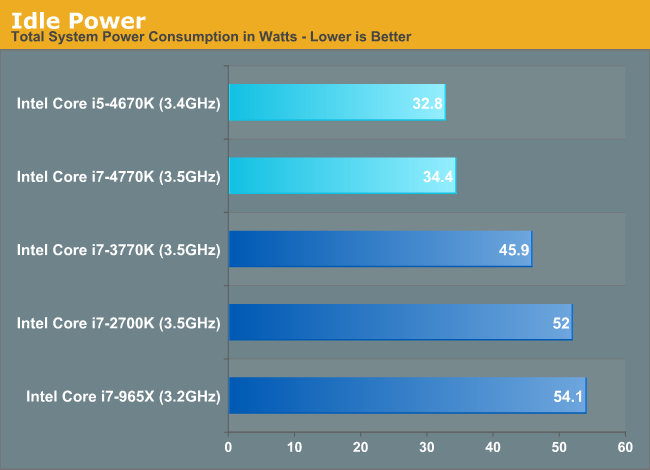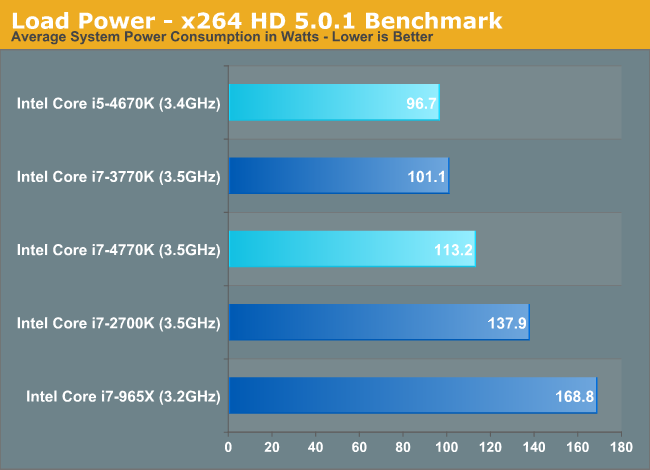The Haswell Review: Intel Core i7-4770K & i5-4670K Tested
by Anand Lal Shimpi on June 1, 2013 10:00 AM ESTPower Improvements
Although Haswell’s platform power is expected to drop considerably in mobile, particularly with Haswell U and Y SKUs (Ultrabooks and ultrathins/tablets), there are benefits to desktop Haswell parts as well.
There’s more fine grained power gating, lower chipset power and the CPU cores can transition between power states about 25% quicker than in Ivy Bridge - allowing the power control unit to be more aggressive in selecting lower power modes. We’ve also seen considerable improvements on lowering platform power consumption at the motherboard level as well. Using ASUS’ Z77 Deluxe and Z87 Deluxe motherboards for the Haswell, Ivy and Sandy Bridge CPUs, I measured significant improvements in idle power consumption:

These savings are beyond what I’d expect from Haswell alone. Intel isn’t the only one looking to make things as best as can be in the absence of any low hanging fruit. The motherboard makers are aggressively polishing their designs in order to grow their marketshare in a very difficult environment.
Under load, there’s no escaping the fact that Haswell can burn more power in pursuit of higher performance:

Here I’m showing an 11.8% increase in power consumption, and in this particular test the Core i7-4770K is 13% faster than the i7-3770K. Power consumption goes up, but so does performance per watt.
The other big part of the Haswell power story is what Intel is calling FIVR: Haswell’s Fully Integrated Voltage Regulator. Through a combination of on-die and on-package circuitry (mostly inductors on-package), Haswell assumes responsibility of distributing voltages to individual blocks and controllers (e.g. PCIe controller, memory controller, processor graphics, etc...). With FIVR, it’s easy to implement tons of voltage rails - which is why Intel doubled the number of internal voltage rails. With more independent voltage rails, there’s more fine grained control over the power delivered to various blocks of Haswell.
Thanks to a relatively high input voltage (on the order of 1.8V), it’s possible to generate quite a bit of current on-package and efficiently distribute power to all areas of the chip. Voltage ramps are 5 - 10x quicker with FIVR than with a traditional on-board voltage regulator implementation.
In order to ensure broad compatibility with memory types, there’s a second input voltage for DRAM as well.
FIVR also comes with a reduction in board area and component cost. I don’t suppose this is going to be a huge deal for desktops (admittedly the space and cost savings are basically non-existent), but it’ll mean a lot for mobile.
No S0ix for Desktop
You’ll notice that I didn’t mention any of the aggressive platform power optimizations in my sections on Haswell power management, that’s because they pretty much don’t apply here. The new active idle (S0ix) states are not supported by any of the desktop SKUs. It’s only the forthcoming Y and U series parts that support S0ix.










210 Comments
View All Comments
gregounech - Saturday, June 1, 2013 - link
Finally, let's see how good Haswell is.Krysto - Saturday, June 1, 2013 - link
Disappointing, to say the least. He's even comparing it to 2-3 older generations, just to be able to write some non-embarrassing numbers in the review, considering Haswell is only like 5-10% faster than IVB.The only big improvement seems to be in idle power consumption, of about 30%, which seems to "impress" Anand, but it just means that if your laptop had a 12h idle time, now it gets 16h.
It won't do much in ACTIVE power, which is really what matters. So much for all the "Haswell will totally dominate tablets in the near future" hype from Anand. Yes, this is not the mobile version, if Haswell really were an impressive design for power consumption, you'd see it here, too. It actually consumes 5-10% more than same clock speed IVB chip, which means its extra performance is almost completely negated.
This means that my predictions that Intel will try to "trick" us into thinking Haswell is ready for tablets will soon come true. Because if Haswell is not that efficient to warrant being used in "normal" tablets, then they'll try to dramatically lower clock speed and performance to even achieve 10W TDP (still too high for a tablet).
gregounech - Saturday, June 1, 2013 - link
Pretty good points.I'll still upgrade from my i5 750, and we won't get anything interesting until Skylake on the desktop (apparently, it wont be BGA), as I'm expecting motherboard OEMs to force us into buying their high end motherboards with any of the high end i7s Broadwell.
Samus - Sunday, June 2, 2013 - link
I'm using an i7-950 (over 4 years old) and its funny seeing how still-competitive it is to Intel's newest chips. It seems Sandy Bridge brought the bang and its just been trickle down performance since...Deelron - Sunday, June 2, 2013 - link
No kidding, I'm in the same boat and was thinking of upgrading but with my moderate over clock and these results have no problem waiting until the next generation.klmccaughey - Monday, June 3, 2013 - link
I'm still running my i5-2500k @ 4.3GHz and see nothing here of interest. I don't see myself upgrading any time soon.Hrel - Monday, June 3, 2013 - link
I'm still running an E8400. I see plenty of reason to upgrade.dananski - Monday, June 3, 2013 - link
Ahh I had one of those until this time last year. The E8400 found a happy home with a friend and I went to Ivy Bridge. Even small improvements like Sandy -> Ivy -> Haswell are useful, so don't feel too bad for having waited so long.vol7ron - Tuesday, June 4, 2013 - link
haha. I'm still running an OC'd E6600 (amongst others) for my desktop, which I hardly touch anymore, and am unsure whether to upgrade. I'm curious to see how Haswell performance vs power consumption vs price, is for NAS systems.Aside from natural degradation in one of the components (cpu, memory, psu, or gpu), which brings on an error every once in a while, the E6600 still does 98% of what I want of it and 100% of what I need it to do. So I suppose my needs are to get my electric bill down.
I need to read more because I was hoping this chip would bring me to buy a Surface Pro.
slickr - Wednesday, June 5, 2013 - link
You will get benefits upgrading from E6600 no doubt about it. For you its worth it as you are going to get a lot less power consumption, cooler operating chip and less noisy as well, with a significant performance increase especially in multithreaded applications, but for those thinking upgrading from Sandy or Ivy bridge to Haswell its worthless.I mean upgrading from 2500k to the new 4770k is useless. At best you are going to see 40% performance improvement which calculates into 5 seconds faster decoding or 5 seconds faster unzipping, but at worst you are going to get 2% performance increase which amounts to milliseconds of faster decoding and stuff.
You are not going to get less power consumption and it seems you may even get worse power consumption at loads. The new chips don't even overclock as well either, so its a waste of money to upgrade. If you have 3-4 generations older chip its worth upgrading, but else your money is better spent elsewhere.